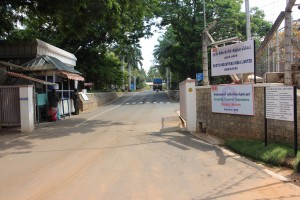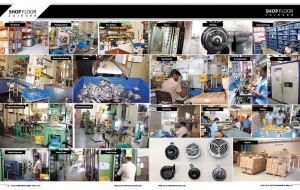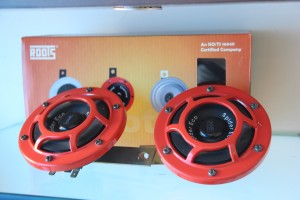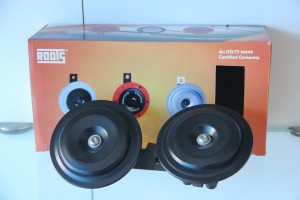Text: Bhargav TS
The Roots Industries plant in Coimbatore makes around 6.5 lakh horns every month, manufactured according to IS 1884 standards that comply to all Indian and international (ECE) regulations. It produces 15 to 20 models ranging in diameter from 70mm to 150mm and supplies to all the major OEMs both in domestic as well as the export market. The company is also present strongly in the aftermarket business and has around 90 distributors across India.
An automobile has a lot of safety components, which are not seen and felt unless a necessity arises. But a component that is used every day and helps avert major accidents is the electric horn that alerts and saves more lives during the daily commute. Over the decades electric horns have been transformed with manufacturers developing new models to keep the market alive. To capture the frequencies and amplitude, Auto Components India visited Coimbatore-based electric horn maker Roots Industries India Ltd (RIL) to understand how this small component is manufactured that plays a vital role in safety aspects.
Some horn developments have been purely technical, but others have turned upon the physics of sound. Designers have found, for instance, that pitch is more important than loudness in achieving and carrying sound power, and that loud sounds are not so unpleasant if air-blown trumpets are used on cross-country trucks and buses, and as custom accessories for passenger cars. They work like trumpets in a band with vibrating reeds or diaphragms taking the place of player’s lips. Horns are mostly electrical to warn passersby of other automobiles. As the utilisation of automobiles is increasing day by day due to increase in population and living standards of countrymen, the use of this product is also going up.
A normal horn consists of about 70 parts; Roots manufactures around 85% inhouse and the rest is outsourced. A typical car horn consists of a flexible metal diaphragm (usually made of spring steel), a coil of wire that forms an electromagnet, a switch and a housing that functions somewhat like a megaphone. The entire apparatus functions according to Hooke’s Law, which states, “The extension of a spring is directly proportional to the load applied, provided the limit of proportionality is not exceeded.”
Press Shop
The company receives raw material as sheet metal strips which are loaded into the press machines. In the press shop, components like housing, diaphragm, tone disc and bracket are manufactured in different press machines. The entire operation is made in a single press and comes ready for painting. Diaphragm and tone disc should be manufactured at high levels of accuracy; Roots Industries does this – manufacturing with high precision.
Painting
Once the components are manufactured in the press shop, they are sent to the paint shop, where they go through several stages before painting. The company uses powder coating to avoid rust and other external damage; therefore it is treated in a sequence of operations to remove rust, oil and water. The paint shop is a single line process, where the components are fed in at one end and painted at the end of the line. In this line, the components first enter the degreasing line, where the oil present in them is removed, and then washed with water. They then enter the zinc phospating chamber where a thin layer of zinc is formed that acts as a bonding and additive material.
When the components are dried, they enter the powder coating facility. Here the components are powder coated with the help of electrostatic charge coating and finally sent to the oven for curing, where the paint is dried at 220 degree Centigrade. After curing the components are tested and sent to the assembly line.
Coil Winding & Horn Assembly
Coil winding is said to be the critical aspect of horn manufacturing, for which the company has created a dedicated coil winding line where all the different kinds of coils are manufactured very precisely. Once the coil winding is done and the other components are painted, they travel to the assembly line, where these components are assembled according to the assembly sequence. In order to avoid mistakes, Roots Industries has made several poke yokes (mistake proofing) so that the operator is guided through sensors about which component has to go in next. If the operator misses to assemble a component, the machine stops and indicates that there is a mistake in the assembly process. To curtail rejections, the sensors even check critical components before they are assembled. If the machine senses any mistake in the component, it is placed in the non-confirmation box where it will be verified by the quality department.
To complete the assembly, each horn has to pass through 13 stages like terminal fixing and coil assembly, contact point fixing, diaphragm assembly, housing and diaphragm assembly, grill or trumpet assembly and mounting bracket fixing. Once the assembly is completed, all the horns are tested and verified according to rated voltage ranges. After testing, they are visually checked and packed according to the models, and dispatched. The company’s assembly shop has a total of 17 lines that manufacture different horns including 4 for OEMs, 2 for exports and the rest for the aftermarket.
Working principle of electric horn
Horns are constructed with a flexible electrical contact that is attached to, or actuated by, the flexible diaphragm. To produce sound when the horn is pressed, an electromagnet is used to cause the steel diaphragm to move. As current is applied to the electromagnet the diaphragm moves towards the core. During displacement of the diaphragm, the closed contacts are opened, temporarily disconnecting the current and allowing the diaphragm to relax. Once this happens, the contacts close, applying current to the electromagnet, which again moves the diaphragm towards the core. This cycle repeats evenly causing the diaphragm to oscillate and vibrate the air column through the trumpet, producing sound. Recent developments at RIL replace the contacts with an electronic circuit for higher reliability and service-free operation.
To create a loud and sustained sound that is often in excess of 90 decibels in sound pressure takes a lot of energy. That energy is electrical current, and is also the reason to use a relay to actuate the horns. Horns come with an endless variety of notes or frequencies. The note of a horn is determined by the flexibility of the diaphragm, its physical size, the power of the electromagnet, the mass of the diaphragm, the mechanical arrangement of the switch contacts, the size and shape of the horn’s case and a number of other contributing factors.
Roots Industries is the flagship of the group, a leading manufacturer of electric and electronic horns in India; also a key player in the international and domestic OE market, able to sustain its lead position for well over 3 decades now. RIL is the first Indian company to be certified with ISO/TS 16949; it also complies to ISO 14001 certification. Roots Auto Products Pvt Ltd is the country’s largest supplier of air horns and a market leader. RIL is a preferred supplier of electric horns to leading OEM’s all over the world.
Demand for this product has enormous scale worldwide. This product can be an ancillary to major automobile manufacturers in the country. Automobile manufacturers associations can provide tremendous market potential for these horns. The main scope of the market for this product will be in new installations and the aftermarket.
INTERACTION: K Ramasamy, Chairman, Roots Industries India Ltd
Q: What is the capacity utilisation of the plant and what are the expansion plans?
Ramasamy: The capacity utilisation of the plant is 75%. As a strategy, capacity expansion is planned once 80% of the installed capacity has been utilised, and it is a continuous process.
Q: What are the various value engineering steps you have implemented for products manufactured here?
Ramasamy: Standardisation, alternate material, simplified manufacturing tools and process are the various value engineering steps we have implemented for the products manufactured.
Q: Tell us about the quality system in this plant, to send flawless products to your customers?
Ramasamy: Roots is an ISO/TS 16949 company. Every activity and process is system driven with poke yokes in every critical stage to ensure flawless products reach our customers. Our approach is customer centric and voice of customers is periodically captured and duly incorporated after evaluation. Quality is a continuous journey in all our activities.
Q: What is the current ppm level and how do you plan to contain it further?
Ramasamy: We are working with ‘zero ppm’ for most of the customers and overall our ppm level is in single digits.

















